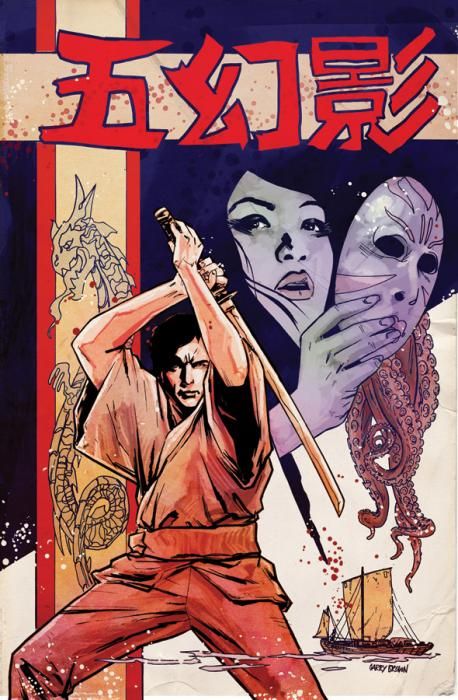When Fabian Grey receives a letter from an old friend, he travels across the world to come to her aid, only to find her dilemma more tied to his own than he could have imagined. Frank J. Barbiere's "Five Ghosts" comes swinging back with more adventures in its sixth issue, seeing a slight change in pace as Garry Brown replaces Chris Mooneyham on art for an issue. In this one-shot story arc, Barbiere expands Fabian's history and training by introducing two fascinating if underdeveloped characters, while Brown struggles with heavy shading and undetailed figure work.
Fabian's trip implies more about his past than it actually spells out. While this ambiguity is ultimately effective by allowing more room for story development, it does draw away from the plot in its insistence on glossing over necessary details. For instance, the story's villain goes unnamed for the entirety of the issue, even though her tie to Fabian and his sensei is implicit. Likewise, Hisano's name isn't revealed until over half way through the comic; her employment and subsequent position, which we are lead to believe is important and influential, is never explained. While a long, elaborate explanation on these matters isn't required for the sake of this plot, the lack of detail prompts questions that test the durability of Barbiere's world building.
Although the story runs a little thin in some aspects, Barbiere does a fantastic job weaving the legend of Masamune into the plot. He fits the entire myth seamlessly into one page, providing just enough detail and flow to keep the reader's attention without distracting from the situation at hand, before utilizing it to its fullest potential. The legend sets up a great parallel to Fabian and his tie to the villain and the Dreamstone, suggesting the different dark paths Fabian could have taken. Additionally, the parallel questions the nature of Fabian's own free will after his accident, setting up some interesting implications about the Dreamstone itself for possible future stories. Barbiere's control of the narrative, at least in this respect, reflects his impressive ability to navigate several different layers of textuality.
Unfortunately, Garry Brown is a weak follow up to the book's regular artist, Chris Mooneyham. Where Mooneyham was light and whimsical, Brown overuses shading to the point of distraction. His focus rests on creating elaborate backgrounds, while his character work suffers from lack of detail; more often than not, figures lack faces completely or have their features run together in a confusing jumble of lines. In one panel, Hisano's costume even changes to something entirely different than the panel before.
That isn't to say, of course, that Brown's work is without its saving graces; his work on the issue is simply hit-or-miss. His representation of the Masamune sword and the souls tied to it resonate in each panel it appears. He creates some wonderfully creepy villain designs, while inserting some gorgeous panels like a title page that is laid out like a vintage movie poster and a panel focused entirely on Hisano's eye detail. He leaves a stunning sunset scene to colorist Lauren Affe, who fills the page with vibrant reds, oranges, and pinks that pop off the page and offset the dark greens and grays of the story.
"Five Ghosts" combines the best elements of "Indiana Jones" and "The League of Extraordinary Gentlemen" for an exciting romp through literary history and the power of imagination. While Frank J. Barbiere and Garry Brown's sixth issue has its weaknesses, the story is pure, inventive fun that bursts with potential.

